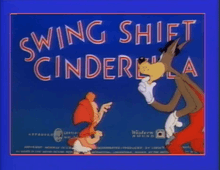Swing Shift Cinderella
Swing Shift Cinderella is a 1945 animated cartoon short subject directed by Tex Avery.[1] The plot involves the Big Bad Wolf and Cinderella. Frank Graham voiced the wolf, and Colleen Collins voiced Cinderella, with Imogene Lynn providing her singing voice.[2]
| Swing Shift Cinderella | |
|---|---|
 Title screen | |
| Directed by | Tex Avery |
| Produced by | Fred Quimby (unc. on original issue) |
| Story by | Heck Allen |
| Starring | Frank Graham Colleen Collins |
| Music by | Scott Bradley |
| Animation by | Ray Abrams Preston Blair Ed Love |
| Color process | Technicolor |
Production company | MGM |
| Distributed by | Metro-Goldwyn-Mayer |
Release date |
|
Running time | 7 minutes, 30 seconds |
| Country | United States |
| Language | English |
Plot
At the beginning of the cartoon, the Big Bad Wolf is chasing Little Red Riding Hood. But then Little Red Riding Hood stops and points out that the two of them are in the wrong cartoon. The Wolf shoos her away and decides to go and meet Cinderella (played by Red from Red Hot Riding Hood). He takes a taxi to her house and immediately falls in love with her upon seeing her, but she sternly rebuffs him. Eventually, Cinderella calls her Fairy Godmother to get rid of him and set her up for that night's ball. The second the Fairy Godmother hears that there is a Wolf, she rushes right over. The Fairy Godmother traps the Wolf, then gives Cinderella a red evening gown and transforms a pumpkin into a Woodie for her to go the ball, but tells Cinderella that she has to get home by midnight (just like in the classic fairy tale).
The oversexed Fairy Godmother then keeps the Wolf busy. She appears before him in an old-fashioned 1890s swimsuit ("Miss Repulsive 1898") and then an evening gown before trying to snuggle up to him on the couch. She chases him all around Cinderella's house, but the Wolf escapes when he gets the Fairy Godmother's wand, turning Cinderella's bathtub into a convertible. He leaves for the nightclub where Cinderella is performing, with the Fairy Godmother in pursuit. Soon after arriving, the Wolf accidentally kisses the Fairy Godmother, thinking she was Cinderella, which only further deepens her lust for the Wolf. Cinderella soon comes out on-stage and performs a show dance while singing the song "Oh Wolfie" (to the tune of "Oh Johnny, Oh Johnny, Oh!"). The Wolf howls and chases after Cinderella, but the smitten Godmother uses various methods (usually a mallet) to keep him in line.
When the clock strikes midnight, the Fairy Godmother warns Cinderella and she leaves, but not before the Wolf starts to pursue his chase. The Godmother once again tries to stop him, but this time, the Wolf uses her own methods against her and pursues Cinderella. Cinderella rushes home as the Fairy Godmother's transformation wears off, but she manages to make it home in time—it turns out that Cinderella is a Rosie the Riveter and that the reason she had to be home by midnight was so she would not be late for the night shift. Cinderella's relieved to be rid of the Wolf, but it is revealed that the bus is full of wolves, who start wolf-whistling and catcalling at her as the cartoon ends.
Crew
- Directed by: Tex Avery
- Story: Heck Allen
- Animation: Ray Abrams, Preston Blair, Ed Love
- Layout: Claude Smith, John Didrik Johnsen
- Backgrounds: John Didrik Johnsen
- Sound Editor: Fred McAlpin
- Music: Scott Bradley
- Co-Producer: William Hanna
- Produced by: Fred Quimby
Analysis
The short includes wartime references. The motor scooter of the fairy godmother displays an "A" gas ration sticker. She later uses a jeep. Cinderella is a welder, working the midnight shift at the Lockweed Aircraft Plant. There is also a female cabdriver depicted, a frequently used motif during the War.[3]
Sources
- Shull, Michael S.; Wilt, David E. (2004), "Filmography 1945", Doing Their Bit: Wartime American Animated Short Films, 1939-1945, McFarland & Company, ISBN 978-0786481699
References
- Lenburg, Jeff (1999). The Encyclopedia of Animated Cartoons. Checkmark Books. pp. 146–147. ISBN 0-8160-3831-7.
- "Swing Shift Cinderella". www.bcdb.com, April 13, 2012
- Shull, Wilt (2004), p. 185